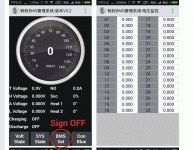spinningmagnets said:
Is it possible to adjust an existing BMS family to balance at 4.1V per P-group?
The title question is different from the first question in your post. To the title question, do any BMS's balance at 4.1V? Yes of course and many have provided examples here. On our LiGo batteries the BMS balances whenever the cells are over 3.8V if there is a voltage discrepancy between them. Also, it does NOT balance when the pack is charging, (or discharging for that matter), it only balances when the battery is sitting idle. That way if there are differences in cell internal resistance (as can happen if there is a temperature gradient in the pack), you won't be balancing cells as a result of the varying cell terminal voltages under load. It will only balance based on the open circuit voltage.
To your first question, is it possible to "adjust" an existing BMS to balance at 4.1V. That of course depends very much on the circuitry and chipset used to make the BMS board. If it's made up of discrete fixed value BMS IC's (usually inexpensive 4s or 5s chips put in series for 10s-14s ebike voltages) then no, if they do bleeding at all it will be triggered by the cell being above a fixed reference voltage. You would have to replace the chip that is on them. But if it's a BMS that has a more advanced analog front end, like some of the BMS IC's from 02Micro and TI etc., then usually you have full control over the conditions when balancing occurs and if you have access to the BMS paramters or the firmware on the micro which is controller the BMS, then you should have no problem modifying it to balance at 4.1V or any voltage for that matter.
I have seen lots of credible data recently
Just recently? This as common lithium battery knowledge goes back many years. However I would concur with what others have said here that the effects (especially of storage at higher voltage) seem to be overstated with current cells. It's like by the time the info suddenly gets mainstream just around the time that the technology has moved past that. There are people who've had 18650 cells in storage for a couple years all sitting at 4.2V/cell and don't see any adverse effect on a capacity discharge test. So this whole claim here
spinningmagnets said:
if you store it over the winter at 4.2V per cell its very bad
May need to have its emphasis revisited. If only it didn't take years to perform these tests we might see more people doing at-home experiments.
Any way to end up with balance-charged pack all the time while always going to only 4.1V? (by any strategy you might think up?)
Yes, buy a battery with a BMS that is smart about when and how it does balancing, and/or get a battery made with such good cell matching and consistency that it doesn't require any active balancing in the first place. Sometimes the only reason a battery goes out of balance is because of the BMS in the first place, and avoid BMS circuits that do that (unbalance cells) like the plague.
spinningmagnets said:
if you charge to a full pack voltage of 4.2V per 13S "48V" pack = 54.6V using a dumb non-balancing 54.6V charger...then some of the cells can arrive at 4.1V per cell, while others arrive at 4.3V per cell (due to variable internal resistances in manufacturing).
This statement in brackets is incorrect. Varying cell internal resistance will not cause a pack to go out of balance, it's varying leakage currents that do that. If the only difference between the cells is that they have varying internal resistance, then the voltage's will spread a little bit
while under full charge current but by the time the charger is at the CV portion they will all taper off to exactly 4.2V / cell.


